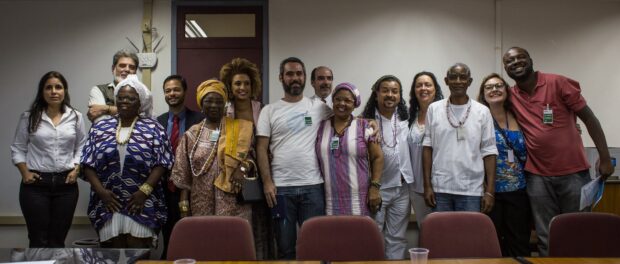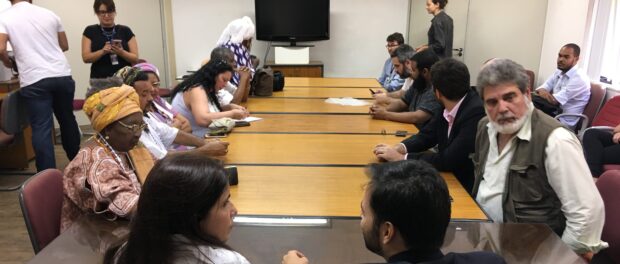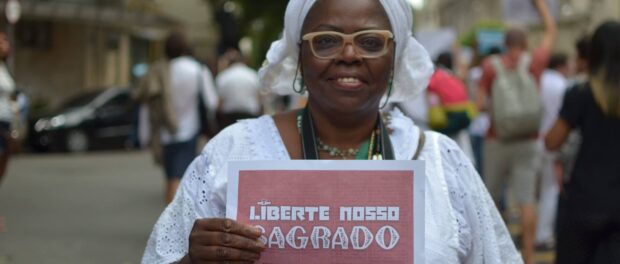
Many of the crimes that brought Maria do Nascimento to a bare conference room on the sixth floor of Rio de Janeiro’s Federal Ministry in August happened more than one hundred years ago. Nascimento, age 80, is also known by her spiritual name, Mãe Meninazinha d´Oxum. She is one of Rio’s best-known and most respected Candomblé priestesses.
Nascimento was at the Federal Ministry to fight for the restitution of sacred objects that were taken away from her ancestors during the First Brazilian Republic (1889-1930) and the era of President Vargas (1930-1945).
Even though Brazil was declared a secular country in 1891, the Penal Code of 1890 still prohibited the practice of Afro-Brazilian culture and religions denigrating Afro-Brazilian beliefs as shamanism and black magic. Violations of the law were penalized with a custodial sentence of up to six months and a fine of up to R$5oo,ooo. The police persecuted followers of religions such as Umbanda and Candomblé. They invaded hundreds of spiritual centers, arrested religious leaders, and impounded their sacred objects as evidence. The discriminatory law was changed with the new Penal Code of 1940 but still applied in practice until 1960.
To this day, more than 200 of these objects—including pictures, musical instruments, offerings, candles, and clothes—are kept in boxes and stored in the State Civil Police’s archives.
For many years now, Maria do Nascimento has been fighting to get them out. Together with other leaders from different religions, researchers, activists from the Black movement, and civil society organizations, she started a campaign this year called “Liberte Nosso Sagrado,” which translates to “free our sacred.”
She explains: “For us, they aren’t just any antiques. They are sacred pieces, taken from our ancestors. The invasion of our sacred space, one of the most intimate parts of our lives, is one of the worst pains. Our sacred is held captive. We are held captive.”

At the Federal Ministry Nascimento and other activists involved in the campaign presented their case to the Human Rights Commission of the Rio de Janeiro Bar Association (OABRJ). The attorneys present, Ana Padilha de Oliveira and Renato de Freitas Machado, assured the activists of their support and promised to reach out to the Civil Police.
For many years, the attitude of the Civil Police toward the treatment of the confiscated sacred objects and their owners has been unrespectful. Until the 1990s, the pieces were available to the public in the Civil Police Museum. The collection was labeled by the disparaging term, “Black Magic,” and the objects were placed next to firearms, evidence from crime scenes, and Nazi memorabilia. Then they were removed from the permanent exhibition and stored in an archive, closed to the public. The title, “Black Magic Collection,” remains until today. In 2010, the museum was closed due to reconstruction works and never opened its doors again. Since then, accessing the sacred objects has become almost impossible. There is neither air conditioning nor any other precautionary measure for conserving the objects and no one knows what state the pieces are currently in.
An independent film producer at Quiprocó Films, Fernando Sousa, is making a documentary about the Liberte Nosso Sagrado campaign. He highlighted how the lack of access prevents both scientific research and the teaching of Afro-Brazilian religion and culture in schools, although the latter is legally required. “For the construction of a democratic society, access is fundamental,” he said during the hearing at the ministry.
Sousa also referred to Brazil’s growing levels of religious intolerance. According to a report from the United Nations released in January 2017, between 2011 and 2015 Rio de Janeiro had more cases filed against religious discrimination than any other state in Brazil. Afro-Brazilian religions were the most common targets of discrimination.

Heloisa Helena Costa Berto, who also goes by the spiritual name Luizinha de Nanã, believes one of the reasons the Civil Police is refusing to return the sacred objects is the simple fact that it would lose large sections of its archives. Berto was a victim of religious intolerance and the City’s abuse of power when her home and spiritual center in Vila Autódromo were demolished to make way for the Olympic Park. Her neighborhood’s Catholic church was left intact. Since then, she has fought actively for housing and religious rights, with the fight against religious racism as her main focus.
For Berto, the conflict about the restitution of the stolen objects goes far beyond religion:
“[It] could represent a break with the past, because the place where the pieces are kept, the seat of the Civil Police, used to be a center for torture during the dictatorship. The sacred objects represent religious racism, but it’s not just religion, because at the time when they were stolen, all expressions of Black culture were forbidden—samba, capoeira, everything. So when they proceed with their philosophy of holding back these pieces, it is like racism still persists.
So the liberation of these pieces would represent an act of liberation with which the people could at least escape this basic oppression… This country is so full of racism and corruption, drowning with problems. You never see the dawn, something good happening. If the people could manage to free these pieces, it would mean reaching a point of happiness, of freedom. It is a strong symbol.”
The campaign participants are already planning where to keep the objects after they have been rescued. The ideal would be to have a museum dedicated to Black culture. Roger Cipó, a photographer, researcher, and Candomblé activist from São Paulo, proposed on his blog that “in the same way Catholic pieces are in the Museum of Sacred Art in Rio de Janeiro, holy Jewish objects are found in the Jewish Museum in Rio, this Afro-religious archive should be in a museum that exalts and respects the religious, historical, and artistic value of the pieces.”
Marcelo Chalréo, president of the OAB, supports the idea to transfer the pieces to a public museum where they can be properly restored and exhibited, although he is concerned that the creation of a new museum will not happen in the near future.
That concern is why Berto suggests the African section of the National Museum as an interim solution. She proposes to establish a shared system of surveillance of the exhibit carried out by different religious priests and priestesses. For her and her fellow campaigners, one thing is for sure: they will never leave their sacred belongings unattended again.
